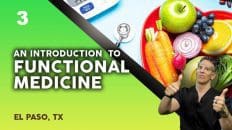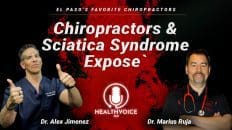Table of Contents
Introduction
In today’s podcast, Dr. Alex Jimenez, Senior Health Coach Kenna Lee Vaughn, and Master Nutritionist Ana Paola Rodriguez Arciniega discuss what melatonin does to the body and how it affects it at a cellular level.
Melatonin Benefits To The Body.
[00:00:00] Dr. Alex Jimenez DC*: Today, we’re going to be discussing melatonin and its effects on the human structure. A lot has been written about melatonin, and a lot of news is moving in the melatonin dynamics. But we’re seeing some correlated issues of how melatonin interacts with the immune system, how it interacts with the whole body approach of treating individuals. It wasn’t very long before you figured out that in today’s COVID world, we were taking melatonin, and it was like, why? Why are people doing melatonin? What does the relationship of melatonin matter in treating disorders? We’ve always heard that it helps restore sleep, but we want to understand a little bit more about the dynamics of melatonin. So I put together my team here, Ana Paola and Kenna Lee Vaughn, on clues. We’re going to go ahead and discuss how we treat and assess dynamics that may require melatonin, particularly in this particular conversation. So today, what we’re going to be discussing is we’re going to be discussing what the issues are of endogenous melatonin, understanding what it means to be a chronabiotic, understanding the phase shifts, and potential exogenous melatonin and the physiological effects of melatonin. We’re going to differentiate between immediate and sustained release. Now, a lot has been said specifically about what is quick release and sustained release. Well, sometimes sustained release. That means that it continues to produce a certain amount of melatonin, depending on particular habits. We may want a spike of it, a continuous release of it, and we have different types of products that we release at other times, depending on the presentation. We’re going to do a little bit of review on the literature. We’re going to discuss how melatonin affects our aging process. We’re going to gain awareness is the foods that are linked to improving melatonin reactions. We’re also going to be talking about some lab works that we do. And ultimately, that gives us, particularly the insights as to how melatonin responds in our bodies and what the patterns are of melatonin in our particular dynamics. Finally, we’re going to end with the COVID dynamics, which explains why so many doctors, including the president of the United States, which was at the time Trump, got infected with COVID. They gave him specific antivirals, but they talked about how they also gave him melatonin. And that was odd along with zinc and vitamin D, and those are other subject matters. But that was a question. Why was melatonin being given to him? So we hope to clarify a little bit of that information, but we are first going to talk about the purpose of melatonin. But no conversation begins better with melatonin. Unless we can talk about where it starts, where it regulates our bodies, and where the beginning is that it kind of, you know, controls are now going dating back from hundreds of years ago. You see, the old Egyptians have the old, third eye thing going on. I have to tell you that much of the modern scientific medicine understands today can relate to the early knowledge because they sensed it. There is a feeling that when you do have melatonin running well, a sense of well-being happens. You feel like your brain is being perfused, and the way your body moves and the way the body reacts to certain chemicals and experiences is adapted by early morning experiences. So what I like to do here is to give you a little anatomical presentation of what we see is where melatonin is. Now in terms of where it locates cells, it works; it sits in the suprachiasmatic nuclei’s brain. Now, if you can look at it here, it’s this red dot. So I’m going to see if I can amplify this better in this picture to picture. It’s that red dot right there, and you can see the pituitary gland sits right here. This is called the hypothalamus area, and this is the thalamus area. So below now is suprachiasmatic. This is a kind of chasm if you can see it on cross-section here. Now in this particular situation, you don’t see because the brains cut are being cut surgically. OK, so what we want to do is we want to do a different type of cut, a different kind of dynamic cut, and we want to look at this particular area where the optic chasm is. And when you look at it from the top, you can see that the suprachiasmatic nucleus is right over the center. Of this little spectrum is called the optic chasm, so it sits right there. The sensors for the suprachiasmatic nuclei are areas of nerves and endings of nerves that can perceive the amount of light coming in from the eyeballs. Those are eyeballs. So what we learn is that right there is where the third eye is. So what they call the dynamics of perceiving light intensity. Lower-level animals don’t have eyeballs. They have light sensors where they can see movements of light. And we have, in essence, an area that sets into motion the body dynamics through melatonin regulation that affects the entire body. So as we all know that if we don’t have good sleep patterns, everything gets affected. And what I like to discuss is the connection between the immune system centers and the inflammatory centers. Now we’ve been watching our prior president, you know, the man never slept. So he was tweeting at like 3:00 in the morning, six o’clock in the morning, seven o’clock in the morning, literally never slept. So this guy is running on energy that we don’t understand, right? Yet, he doesn’t drink. He doesn’t do anything as far as we know. The whole thing is that we got to control this guy. So if he’s got the bug and he got COVID, if he does not sleep, what’s going to happen to his immune system? It’s going to go tailing down, right? So looking at this, you can see how this suprachiasmatic nuclear affects the entire nervous system. So from here, you can see the neurons here that are portrayed that perceive information coming from the optic chasms. With many of our treatments, we’re going to be talking about light therapies. We’re going to be talking about the timing of our therapies, and they’re going to make a big difference. But like I said, it’s one of those things where we want to learn anatomy to understand where this is coming from because it gives a little better perception. So from that point of view, I like explaining a little bit of the effects. As you see here, it has a large effect on many organ systems, from the liver to the kidneys to the heart. It’s crazy how much the information to the ability of the temperature sensor systems of the body. So as we go through here, we start looking at the dynamics, and we talk about melatonin as it is now. We know that it’s in the retina, it’s in the GI tract, it’s in the bone marrow, it’s in the blood, the receptors to this, this area, and it’s where it’s produced, and you have secretion regulated by the suprachiasmatic nuclei. That’s what we were talking about of the hypothalamus, OK? It’s like the master clock. I like looking at it like it’s the master third eye. We can look at it, we can see the clock, and the job is dramatic in the am hours, OK? And usually, it’s lowered by light, and it has an antithesis or another hormone that it works with, cortisol. It works in an inverse relationship which so light activates the cortisol. OK? Think about this now that cortisol lives on our adrenals, a little organ on top of our kidneys, right? So it’s way down there now. It’s always talking to the hypothalamus. It’s going to ask when do you want to go? When do you want to launch, right? And the melatonin goes, No, not now.Stay down. Stay down, cortisol. The increase is going to wake us up, right? And melatonin is going to bring us down. So why would we want cortisol levels to be elevated in the middle of sleep? So we’re going to see that the inverse relationship between cortisol and melatonin is critical to launching the sleep patterns and wants the immune system right and launched the inflammatory system as the way it works. So when we look at those kinds of things, we start looking at these areas as to when it relates. Now here we have a graph of where melatonin elevates. You’ll start noticing that it starts working its way up around eight o’clock at night, now peaking its levels somewhere about three to four hours later at around 3:00 in the morning. Now, these are the patterns that we see now. As normal people, we like to see that we need to understand that stress and cortisol are high in our world. There is nobody that doesn’t have stress now, OK? It is a moment in time where we all have different stress levels, whether it’s financial, emotional; just living with people inside your own house sometimes becomes a stressful environment for all of us, right? So what happens is we all have stress. How long the event is will determine our fate, but there are some things we can do. Look, we don’t need to watch Netflix till 3:00 in the morning. I am also addicted to sometimes watching the pimple lady on Tik Tok, right? But you know what? I’m sitting in there, and it’s 4:00 in the morning, and I’m watching pimples be removed. But what does that do to my sleep? It messes it up, right? So we have to have the ability to kind of go deep into understanding that you’ve got to make yourself go to bed because not only is it a risk to our safe return to health or in our abilities to deal with worldly dynamics that affect our stress system, but it also helps us be able to be resilient and strong. So looking at melatonin is very important. So looking at the peak levels in the night allows us to understand what we see in this curve. We try to understand that as you can look over here, you can see that it peaks at a certain point and starts at a certain. But we definitely don’t want melatonin high in the midday, but we have certain events that caused that now early on in this thing, and we’re going to start talking to my nutritionist, my health coach, in a moment regarding a little bit of what’s going on. But you’ll understand that serotonin melatonin synthesizes serotonin now. By the way, this is a fascinating dynamic, OK? So melatonin synthesizes from serotonin. OK, so here we got serotonin, but we’ll also notice that there are many other factors. So nutrition becomes an important component like B2, B3, iron, zinc. All these make a matter of things that made that alter us and our ability to produce melatonin. A lot has been done with five HTP. Sometimes, when we have low levels in certain patients, we can give ourselves that amount to produce a risk or a direction of high production of melatonin. So if you don’t have it, we have to look at causes for that. We have lab works that we can evaluate. Now here at the suprachiasmatic nuclei, you can see a more of a kind of a cross-section, a pie cut out of the brain. And you can see from here, it has these little block sensors, but you can see that it works on the digestive system. It works on the lungs. You have sensors on the heart, liver, stomach, intestines, sex organs. It is everywhere. So the whole connectivity of melatonin is vast. It has such large effects that people have not realized that over the last decades. But you’ll see through the NCBI that thousands of studies are done per year that is working on understanding melatonin. And that is why our president was given it. The implications are so vast that it helps mitigate the cytokine storm, which is the excessive inflammatory reaction of our immune system. So it gives us also a little bit of ability. Now I’m going to ask Ana a little more specifically in your nutrition practice, how have you seen melatonin play, and what kind of things you see melatonin plays a role in nutritional treatments?
Quality Melatonin Supplements
[00:13:49] Ana Paola: Well, it has a lot to do with; of course, you mentioned serotonin, so it has a lot to do with all of the mood swings and how the person interacts with its environment. So the first thing that I recommend to my patients when they are reporting terrible sleep or maybe add delayed sleep disorder, or perhaps just a mood phase disorder, is to include tryptophan-rich food that is like the first step for me. But of course, many things can influence melatonin production or, as you mentioned, the light. And now we can see that they are like light appliances that led to pain like most of the time as well, we believe in the border between Mexico and the United States. So we are like the borderlands Sun City, so we have plenty of light. But in that particular case, for example, for night shift workers, this whole inspection light could be like an extra step that I would take for them to feel a little safer. And there are like many nighttime workers in our environment, for example, nighttime nurses, which is very helpful for them. Another thing is that, as you mentioned before, melatonin is more like a clock master that organizes the clock network because every single target tissue has different melatonin receptors. So when these receptors get activated by melatonin, it means that they have to work. So it organizes its tissue, and it says, OK, you have to work right now. Cortisol, you have to get up right now, and I’m going to decrease. But it is always working. It’s always keeping all of these little clocks organized, and then it passes through all of the information to the target tissues you mentioned before. So that is an essential part of melatonin synthesis and melatonin suppression. Another thing is that if you pass to the melatonin metabolism pathway, as I said before, melatonin is made from tryptophan. Still, we need a lot of other nutrients for this specific body to function. The first one is this tryptophan hydroxylase enzyme. It has to work with IRA. It has to work with vitamin D. So if there is a deficiency right there. We will have problems training this trip to find and buy HTP. Another thing is that if we’re missing the specific nutrients that release 582 to serotonin, then we’re going to have another issue right there. So, of course, we have serotonin, which will be very important in depression and anxiety issues. And all of these are prevalent conditions that we’re having right now, and we have to take some of these other nutrients. That supplementation is essential. Vitamin D is critical. The assessment of the iron status is vital. So I have to go deep into the nutritional history and know exactly where it’s going wrong? What is the nutrient that I’m missing? What is the enzyme that is not working so that I can supplement something better to my patient? And after that, start working with other treatments like the light, which is a significant factor right there, even more so for teenage students right now, which I think must be challenging to be ahead of and right now, being in front of blue light all of the day and then trying to get distracted and be on your phone the rest of the day, so of course, you’re going to have a circadian rhythm movement right there that is going to be deleted for these patients. So please open a window. Stay outside for 20 minutes with a lot of sunshine. Do some things. Just don’t stare all day into your computer.
[00:19:17] Dr. Alex Jimenez DC*: So one of the things is that when you mention that and we look at things like circadian rhythms, you can see that light plays an essential component. Now you said vitamin D. Well. The light picks up vitamin D on our skin sensors also relates back and forth. It assists the process and is a cool or even a direct enzymatic factor that influences melatonin. So when we start seeing this, we start noticing that it’s essential. Now straying a little bit from the way we see it in our physical medicine type of practice. We may know a person who is well to say this, to say the least well-nourished, and they probably have a BMI well higher than what usually would be between 25 and 28. And they’re thirty-six or forties. A BMI? Well, sometimes what we know is that there may be implications of extreme stress, and the person tells us, well, their weight goes up and down. When you see somebody waking up at dawn, you look for hormonal imbalances. We look for stressors that are affecting the individual, such as cortisol. Now, just following that line of attack, what we do is we want to see whether the effects of cortisol. When we deal with cortisol as an indirect effect of excessive cortisol, we have a friend; a little green monster comes out. That’s called insulin resistance. So that when we notice this insulin resistance, we start seeing things happen, and people start getting more significant. And when I say that we have to look at it from the point of view, when we look at dynamics, we have systems in our office where we evaluate body composition. So body composition or someone has an excessive amount of body fat. For example, in this particular situation, if we see someone with elevated body weight or a system where a body fat mass index is high, we have to figure out what’s going on. So we not only want to look at things from a quantitative point of view, but we also, as a qualitative point of view, how is your sleep? How is your pattern? How’s your libido? All this gets affected directly because a lot of people don’t realize that libido is ultimately implicated. Even this system is affected directly by the suprachiasmatic nucleus that produces the hormone of melatonin. So what we see here is that when God created us, he’s made these fascinating dynamics. It may not be a direct link like the vagus nerve, but these hormones meander to organs and launch them at different points. To your point, Ana, it’s incredible to know that the liver is also asking the question, Are we ready? Are we prepared to launch? Do we want to begin this metabolic process? Does the stomach want to start producing acids in the middle of the night, right? It depends on digestive processes, so a lot has to be done by understanding that this melatonin has a huge reaching effect. So stabilizing its rhythm is critical in figuring out what’s going on. So let’s take a look at the rhythm here as we look at the overlapping circadian rhythm. We look at the normal methods. One of the things is that we want to look at specific components like core body temperature and plasma cortisol. You’re going to notice that as melatonin rises here, right, you’re going to have its friend cortisol goes down, OK, because they control your adrenals, which are these little bean organs in the back, and they’re signaling the brain, when? Because we got to watch. We’ve got to get this guy to get some food. Do what you got to do to survive. Right? But melatonin says no. It’s not time you need to do something. You need to rest. So as you can see that, they’re both inversely related. It’s fascinating that the core body temperature goes down inversely related to also melatonin. And that’s going to come into effect later because we can help mitigate the core body temperature by the amount of dose that we can give an individual with melatonin. So when we go there, we can see that. So what we’re starting to learn today is that because it’s a phasing thing, we want to understand the phases of that. So what I’m going to ask Kenna in a few moments to discuss a bit of the lab that we’re going to be going through because what we’re looking for when we do labs is normal pattern distributions from melatonin dynamics, OK. So I’ll give you a preload of what we look for here and for patterns and changes. So before we go there, I’d like to go ahead and just discuss exactly the early phase or what we call the advanced phase melatonin reaction versus a delayed phase. Now tell us you know a bit of this, Ana, as I’ll gladly explain what happens here: we have melatonin at the early phase. Can you explain a bit of the early phase versus the delayed phase melatonin reaction?
What Is The Difference Between Early Phase and Delay Phase Melatonin Reaction?
[00:24:39] Ana Paola: Yeah, I can. I can do that explanation, but I think I’m going to need an example right here. Well, it has a lot to do with sleep hygiene. So, for example, there comes like this patient that says, “Hey, you know, I crash right after I have my lunch hour, and I have to sleep, and most of the time, I try to get a nap like a 15-minute nap. But it turns out that I just blackout for two hours.” So this means that our melatonin peak phase is already advanced, or it could be delayed. This could happen in those patients who wake up and are so tired as they wake up at eight a.m. Saying, like staying up at some hour before they get out of bed and feel so tired. Sometimes they want to get back to sleep, which means their melatonin secretion phase is delayed. They are secreting that more significant amounts of melatonin right after the two a.m. to four a.m. peak when you are where you are finally in. So this means that there could be many things that have a lot to do with the amount of time that we spend looking at our monitor or the fact that we are not going out of our house. So that lumen, which is like the measurement of light that we are getting to our windpipe through our retina, is not correctly being distributed or is not activating the secretion of melatonin the way it should be secreted. Sometimes or most of the time, that creates the entire life-creating side like the ones that help the light clean the therapeutic one.
[00:27:06] Dr. Alex Jimenez DC*: So let me ask you this. So what we do is realize that these are the full-spectrum lights, and these lights suppress the melatonin reaction for a later time, so we want it to be coming out at the right time. So by using these lights, we suppress very much if we’re going to make sure this thing comes out at a later date if it comes out earlier, correct?
[00:27:32] Ana Paola: Yeah, it works depending on the diagnosis; if it’s like an advanced phase rhythm that we have there or if it’s that delayed phase of the melatonin suppression, the main thing that we have to do is we need to have a routine because most of the time you can see right here that the melatonin production mainly increases when the sun starts to come down. So we have to make sure that our body is getting that final language that we need to start producing melatonin to rest it. But of course, the stress and cortisol will inhibit this particular hormone right here because they counteract. So we have to do a very close assessment of the cortisol release and melatonin release we are having and how they interact. Because as you said before, melatonin is like the first signaling pathway that will lead to immunological factors to the hydrochloric release in our cell and all of the protection of the gastrointestinal tract that comes with carbonate that is released melatonin and that in the cortisol. And other things that are controlled by melatonin are anti-inflammatory or interleukin that will modulate saying when that inflammatory response that we are having.
What Kind of Test Helps With Melatonin Influence?
[00:29:25] Dr. Alex Jimenez DC*: When you say the immune modulation by those immunoglobulins or IG1s, IG2s, IG3s, IG27s. These all can respond based on even the melatonin influence. Tell us a little bit, Kenna; can you connect in the labs if you can do that? And if not, then I’ll continue to do this. We do labs from Doctors’ Data that help us, and this is only one of the companies that we’re using to assess where your melatonin reaction is. So we have two choices. One which is the serum. Also, we have saliva because one of the things is that the saliva also lets us know how much the melatonin is and how much cortisol. So today, the circulatory system is linked to even saliva production because of the glands, so we can actually see and measure where the melatonin versus cortisol is using diagnostic testing procedures from the Dutch test and the Doctors’ Data melatonin reports. So tell us a bit of that, Kenna, if you may.
[00:30:36] Kenna Vaughn: Yes. So this test is going to be done with four separate saliva samples. That way, we can watch throughout your entire day what’s happening, where levels are spiking, and when they’re going down.
[00:30:51] Dr. Alex Jimenez DC*: Oh, I love this. Women under stress. I love that. Hey, I wonder what the cortisol level is on you now? Go ahead, continue this, if you can; if not, that’s OK. When she was doing that, which she was, you can see is that we all have the dynamics of stress. So having kids of my own, you know what? we just know how to tune that out, right? By the way, have you ever been able to deal with or see how parents sometimes have the kids screaming and they just can have a normal conversation? Because I know that there’s an ability, a third ability, and an intuitive ability to tune that out. But on audios, it corrupted a little bit there. The idea here is to see exactly where the melatonin should rise in this particular dynamic. Here we have an individual whose normal melatonin should be rising in the evening time is low. OK, so here’s a problem because the individual can’t sleep well, they come in with over, you know, increased body weight and they’ve had stress the entire time. Well, here’s the crazy part about it, right? Well, not only does the stress create inflammatory reactions, but it constantly allows for insulin resistance. And what we see is an individual that’s not only in pain but is also overweight. So what we look at is when we evaluate these dynamics, we can see that the connection in functional medicine is to be able to connect the dots and be able to ask the right questions to determine how can an anthropometric measurement of body fat analysis, how much water the intra extracellular water because all the systems are controlled by melatonin to some extent, the wisdom is far beyond. We’re just learning as we’re getting this again. Twenty years ago, melatonin was the thing to reset your time clock as you were flying on an airplane. Today, we’re seeing it being used for COVID. So as a mitigating factor, as a supplemental treatment to preventing a cytokine storm by modulating the immune system and keeping everything in check. It’s amazing how good things are free in this world. So the dynamics of this is to be able to assess that. So our laboratory test, whether through Dutch or through Doctor’s Data or through other companies that we use like Vibrance, can determine exactly where your levels are because one thing is me talking about it. One thing is an individual presenting, but we need to prove this, and we need to be able to see quantifiable changes in the dynamics to see what we’re going to do so that we can correctly change and modify the diets. OK, because once we do that, we realize that stress-relieving factors, lifestyle changes, food, and dietary changes, you know, the human circadian rhythms. We have to protect that in today’s world because those people run the clock in the wrong way, those who eat the wrong way, those who have constant, elevated stress and have a real high BMI. We’re looking at a perfect storm of dynamics where the person can be very vulnerable in this world in this time today and what we call the COVID era. Now let me go back into the presentation a little bit as we kind of digress a little bit. Ana, you were talking about the luxe now. The ability of light to be in our system is to suppress the melatonin and allow it to come out at a different time. If you teach it and reset it with light therapy, you can time the melatonin. And when it doesn’t get produced, or it gets produced too late, we can bring it in by taking supplementation. OK, so there are other things that we can do, but it just shows you that when we measure, we see that if you work inside a rainy day, this is the lux you need. 100000 lux is good. So this is what Ana was talking about, relating to indoor light. Now, if you work indoors, you don’t have enough lux or the measurement of spectrum light to be able to suppress the melatonin, and the darn thing just floats around, making you kind of messed up. And when it needs to trigger, it doesn’t trigger appropriately, if that makes sense. When we do these, we have these products here that we use. Now the ability to suppress evening light becomes important. Now dosing in therapeutic areas. Now one of the things that we’ve looked at is when you go to the store, you start noticing, you know, melatonin products that are out there that start at two to three milligrams of it. Some of them are even up to 20 mg now. One of the things is is that we’re not too sure at this present time. Does melatonin cause the activation of the sleep dynamics, or is it the mechanism that opens the gate if it’s the open the gate dynamics? That’s why the new theories use lower doses that open the gate to allow the process to mitigate itself and present itself. So we don’t need high doses as we’re starting to learn because, at high doses, we don’t have much more effect than we have at low doses. So the best option for medicine is always to use the least possible treatment dose that works. So what we look at these a little bit about dose comparative studies, we can see that 0.3mg to 2.5mg. Half the mg is as effective at reducing sleep latency in age-related insomnia as three and five. So why do that? Why tamper with the system? So you now use low doses 0.5 mg versus 20 more effective at lady circadian rhythms in the sighted person? OK, so what we need to do is we need to be able to know the difference between using point five to 20 milligrams. The higher doses also change the body temperature. Now, what does this matter? Because when someone says to you, you know when I wake up sweaty and in the middle of the night, I’m just hot, right? And then it may be because of its metabolism or just because their circadian rhythm is off. The ability to take in a little bit of elevated melatonin will suppress the body core temperature. Now you’ll remember that if you see here, the core body temperature diminishes based on the ability to also increase with melatonin. So if you see this number go up, you most likely will see that number or the red one, which is the core body temperature change which is indicative. And when we look at sleep studies, when someone sleeps in a cool room, usually around sixty-five degrees, they get more ability to go into REM, OK, which is the rapid eye movement which all metabolic processes kind of like start repairing and fixing the body and dealing with it. No matter what we do, no matter how we treat people, there is no way to supplement away sleep. OK, as I can take vitamin E to avoid sleep or take this to avoid sleep. No, our body needs to sleep like normal dynamics, and we must be understanding of that. As we look at that, we need to see that the most important thing is to get the rhythm to work properly. Now I know Kenna was in the midst of a kind of talking about this. Did you want to go that thumbs up, or can we do it? Or what is our guy say? Go ahead.
[00:38:41] Kenna Vaughn: Yeah. So this test, like I was saying earlier, is made up of four different saliva collections. The first one, the individual will take 30 minutes after they wake up. This will be a great way to see what’s going on in the morning if their melatonin is coming down, how high it is when they wake up, things like that. When we take these saliva tests, we’re going to want the individual to rinse their mouth out with just plain water about 10 minutes before the test. That way, the melatonin that we are collecting in the saliva is pure. It’s not being influenced by any foods they ate, toothpaste, toothbrush, or things like that. So the water is going to be a crucial factor in this test. The second one that the patient is going to do is going to be right before lunchtime. Once again, we’re just seeing where their melatonin is in the middle of the day. The third one will be before dinner, and the fourth one will be right before bed. So with these four collections, we get these graphs, these points marked on the graph so we can track like I said, what’s going on throughout the day where their rhythms are going? As Ana mentioned earlier, how can we enforce those with melatonin or maybe by getting some different light into their system? All those things impact sleep, which is highly, highly important. And this is a great test to do. We can even repeat it in a few months to see if there are improvements with their cycles.
Children and Melatonin
[00:40:14] Dr. Alex Jimenez DC*: That is awesome. You know what? I want to ask our resident breastfeeding expert here, Ana Paola Rodriguez Arciniega, about the importance of melatonin. Right now, we have a young lady who is at a particular moment in time, Mrs. Kenna Lee Vaughn. There’s our little child Landry, who is benefiting from a huge amount of melatonin. Let me ask you, Ana, as we look at it from our creator’s holistic, spiritual sense. Why would God give melatonin to a child, and how does that work?
[00:40:57] Ana Paola: Well, it works from the beginning of the life conception, I might add because melatonin is one of those hormones that can easily pass the placenta membrane. And as we know, it’s kind of a barrier right there that allows something to enter and something to say; it just keeps it out. So melatonin is like one of the hormones that can easily pass through the placenta membrane, and it’s part of the baby’s environment from the second the conception is done. But something essential here is that after birth, there is also high levels of melatonin concentrations, then the number one in the colostrum, the first 45 days of the colostrum intake of the baby. They have vast concentrations of melatonin. Breast milk has an enormous concentration of melatonin in the nighttime while in the morning, and it has low concentrations of melatonin. So it changes. It has a circadian rhythm, but there is something in, and I guess that all of the parents will let me lie on this because the first three months of the baby’s circadian rhythm is all over the place. And it seems to be like this kind of thing that the baby is not fully getting the melatonin or fully metabolizing the melatonin. They’re getting ready to function, but it’s only going to start to function after just three months supply. So that when the baby begins to sleep like a six to eight hours kind of nice sleep or something. I’m sorry, I don’t have babies. I just know things about babies and breast milk because I love that topic. But that’s how it happens, and it has a strange way of functioning. Still, it’s right there for the baby to start knowing their circadian rhythms and when their receptors, their M1, M2, M3 receptors, start to take all of that melatonin and start to function correctly.
[00:43:38] Dr. Alex Jimenez DC*: So let me ask you from a study point of view. By using the dynamics, can you see the difference when breast milk is given to your baby? Does she go out, or is nap time coming from an actual live study here?
[00:44:02] Kenna Vaughn: Yes, she is on a nap and sleep schedules. So around the same time, every day when I feed her to go to bed, that’s the feed that will put her to sleep. When she wakes up and eats, she stays awake during her wake windows. Another thing you can do to help babies learn their rhythms when they wake up is to feed them by a window, or she can tell you herself.
[00:44:33] Dr. Alex Jimenez DC*: Yeah, that’s right. So tell us, Landry.
[00:44:37] Kenna Vaughn: Feed them by a window when they wake up versus feeding them in a dark room to go to sleep helps them as well.
[00:44:45] Ana Paola: Yes. And that is something else that helps in the last breast milk feeding you’re having with your baby late at night, and it should be with that same light or in a dark room for them to calm down and have a better sleep. So yeah, that’s what happened.
[00:45:07] Dr. Alex Jimenez DC*: What I gather from this, and as we get deeper into this thing, we’re going to start seeing that melatonin has far-reaching effects that are beyond the beginning of the sleep pattern. This is setting the immune system and all the things discussed into motion. So we see that this began many years ago when it was being given to people for jetlag to fly to Spain from America. You’re in a whole different time zone, OK, so you need to reset your time clock. And this was a fast way of resetting it. But it wasn’t very clear because people didn’t know when to take it or how to take it. So based on these studies, we now know that there’s an appropriate mechanism and a timing structure to take. Now I believe that we have even a timing cycle, but we’ll probably discuss that as time goes on. But let’s go ahead and talk about it a little bit. Let me go back here, and we were going to go melatonin dosing and went to therapeutics. The effects on women seem to be a little bit more improved. I mean, women get affected more by melatonin, the quality of sleep, its significance within six to eight weeks of supplementation, improvement, and quality of length of sleep. So we do it for some time. When we do that, can you give a little bit of kind of instructions that you provide the patients when you do this and tell us a bit of that, Ana?
Does The Quality of Melatonin Affects Sleep Routines?
[00:46:34] Ana Paola: Well, it’s something that I say is that it depends on the quality of melatonin that you’re taking. Most of the time, people grab an over-the-counter melatonin supplementation bottle and pop it in their mouth. And first of all, sometimes it has a higher dose of melatonin, and we still do not know how it properly works and why higher amounts of melatonin sometimes are not efficient for this patient? So we have to consider that the first thing that we have to do is provide the patient with the proper supplementation and medical-grade melatonin supplementation. That’s like the first part of that. The second part is that vitamin supplementation that comes with it because melatonin will be like the last step of the process in the metabolic pathway. But we can improve it by keeping that trip to find supplement supply at an excellent level and providing all of the vitamins that supply cofactors for those specific enzymes that we talked about just now. Another thing is that it won’t work directly like, OK, you’re taking melatonin today, and you’re going to fall asleep right after that. Most of the time, the patient has to be very patient with it, and it takes about four to six weeks for it to have some effect on it finally. We have to talk about the time or the sustained release of these specific melatonin supplementations, so sometimes they take a fast-acting dose of melatonin, and they need to sleep like 15 minutes after they take it. So yes, that’s something that you have to take into account. But are you waking up four hours later in the middle of the night? What is happening with that fast-release melatonin that you’re taking? And this has a lot to do with diagnosing a delayed phase or alternative phase melatonin release. Another thing is that if we talk about fast-acting melatonin, then we have to talk about the sustained release melatonin that works 60 minutes after work, and it is taken and can last like four to eight hours. And another thing, of course, is the metabolism of melatonin. Melatonin has to go to two weeks of metabolism. The first one is the liver and the second one is the kidney metabolism. And it gets out of our body real fast through urine. So we have to consider that we can assess melatonin by a urine sample, but it’s easier to do it with saliva testing.
Keeping A Night Routine
[00:49:47] Dr. Alex Jimenez DC*: You know, I’m going to digress a little bit because that’s critical information. We’re starting to notice that people who have older parents who live to find out when we should start taking this stuff, when it is appropriate to the life cycle, to a child, puberty, and aging? We first have to look at the patterns, and when we look at that, we see that melatonin is heavily produced when you’re a child. Right? You can see that somewhere around the 40s and 50s; it starts affecting. Well, that’s when people are working. That’s when people are trying to build their future. This is when you start waking up into life, and you start saying, You know what? I have to plan my life better. I have to redirect, and worries come in. Right? Well, that’s where people stop sleeping while their patterns, work, and overload increase. And what we got to do is we got to be able to educate our patients to understand that there’s a normal process of change through the normal melatonin release dynamics. We all have are those who have lived with grandparents wonder why grandma wakes up at 5:00 in the morning. She’s like the earliest to wake up. It’s like, grandma, you don’t sleep. As I was sharing with my staff earlier, I have a story that is that when I was younger. I was in my teens somewhere around here. My dad would look at me, goes, Man, are you taking drugs? Are you sleeping all the time? What do you do? And I was like, No, I’m not taking drugs. I just love to sleep. And those of us who have teenagers in our home realize that they love to rest and enjoy their sleep. And in today’s world of COVID and working from home, from school, home is school and school is home. We realize that many kids are in their beds, and they’re sleeping in, and their patterns are thrown off. So we can see that at an early age. You can see that when you do have those dynamics in this particular area when you’re in their teens, you can see that it does affect if sleep patterns are derailed as we look at the areas of things that affect melatonin release. Maybe you can add a little insight into this, Ana, precisely because you do dietary changes. What do you look for things to make it produce better?
[00:52:10] Ana Paola: Ooh, that fits a lot with a nighttime routine, which I like to call it. Of course, alcohol before bedtime works like a fast-acting melatonin kind of supplementation, but it will wake you up like four hours faster. And I’m not telling you that you should test that.
[00:52:35] Dr. Alex Jimenez DC*: So what you’re saying that alcohol starts making you sleep better, and then it wakes you up? Got it.
[00:52:40] Ana Paola: Yes, and then it wakes you up? Yeah, like four hours after you take it. So don’t ever do that. That isn’t good for your night routine. Another thing that you mentioned is that most of our teenagers are starting from their bed. So that messes up the fact that we are kind of we’re admitting that our bed is not for resting, is to work, relaxing, watching TV, spending some time on the phone, and maybe even eating at your bed. Now the bed is solely for sleep and for something else that starts with the neck. So that thing that you need to get fixed. Another thing that you mentioned…
[00:53:36] Dr. Alex Jimenez DC*: But that is why we have the podcast here. We got the bed and melatonin, and I think I let it go.
The Sacred Bed
[00:53:39] Ana Paola: Yeah, it’s essential to keep your bed as a sacred place, and it only works for that. And the other thing that you mentioned is this temperature. We have to keep our bed setting or our room in a very cold temperature kind of way. You said 65 Fahrenheit, so that would be a suitable temperature for your room to be in. Another thing is that maybe keeping your dog in your bed is not probably a good idea, just in case your dog snores or passes gas. And it’s very smelly. That is not a good idea.
[00:54:25] Dr. Alex Jimenez DC*: Oh yeah. All right.
[00:54:31] Ana Paola: We’re having problems with your sleep routine. You’re going to have issues with your melatonin suppression. So I think that all of those specific points lead to that final point right there as it’s essential we need to keep a nighttime routine. We need to stop drinking coffee right before we go to sleep. We feel that coffee will accentuate our activation mode. And now they’re saying that chocolate is probably not a good idea for melatonin release. Teas are a good precursor of melatonin because we have found that camomile tea and green tea can induce better sleep. So we can use that. And even wine can boost melatonin production. But as I said before, high amounts of alcohol may lead to a fast sleeping mode, and then will eventually wake you up in four hours because, like stopped that cycle right there. So there are many things that we have to take into account to have a better sleep in this time that we are leaving, which is like a COVID time.
[00:56:00] Dr. Alex Jimenez DC*: Let me ask you about types of dietary changes. I have up here a study on melatonin and the Mediterranean diet perspective. Tell me a bit of how you added, and you change people’s or maybe work on people’s diets, specifically in your world of melatonin. Tell me a bit about what you do.
[00:56:19] Ana Paola: Well, some think we need to discuss the Mediterranean diet because it is rich in phytonutrients and is very hard to digest. They spend most of their time in our upper intestinal tract and the lower intestinal tract. So what I mean by this is that they spend a lot of time interacting with our mucosa and our microbiota. And why is this so interesting, and why does this have to do something with melatonin? It’s because, as we said before, melatonin is secreted by the pineal gland. But, like most of the melatonin is secreted by the GI tract by four hundredfold more. So that is an essential part of the phytonutrients that we can find in the Mediterranean diet. Another thing that’s a good function in terms of the Mediterranean diet is that it has a. A lot of fish content right there. And fish is rich in tryptophan, which will lead to a better synthesis of melatonin and serotonin. So it has a lot to do with the macronutrients, the phytonutrients, the amino acids that it possesses, the interaction of the metabolites with our gastrointestinal tract, and how they will ensure that finally and how it will serve the melatonin to keep working. Another thing is that the Mediterranean diet is rich in omega-three fatty acids, and we did say that melatonin is the first to step up to the circadian rhythm. But it would be like, why are you supplementing melatonin if you’re having such an awful diet? But if you keep your melatonin supplementation, change your diet to a Mediterranean diet, you will improve the inflammatory effects of melatonin with that high EPA and DHEA from the Mediterranean diet. And they will act together so that it’s like a plus point right there with the Mediterranean diet and that interaction with the melatonin that could help and improve it.
Conclusion
[00:58:56] Dr. Alex Jimenez DC*: Clearly, the Mediterranean diet has far-reaching effects, and the studies relating to melatonin show massive results and tremendous relationships. We realize that the diversity of the phytonutrients is what is essential in this dynamic. The Mediterranean diet is just from the phytonutrients side of things. So when we have a very colorful type of diet or fibers, such as if you can imagine going to a salad place, Whole Foods, or an organic place. The whole idea is to understand that the variety in colors is what our eyes are geared to look at. So the more variety of color helps us in our diet. So I know we’ve covered a lot today, OK? And what we’re going to do is we’re going to continue this on the next time around, and we’re going to go ahead, and we’re going to focus on the COVID relationships of the melatonin. And we’re going to have to find out a little more about what Landry has to say about these diets specifically and high melatonin, because I think from what we’ve learned today, melatonin is essential to Landry, so it’s vital to that. So I was coming up with ways to get melatonin, but I think my lady will hit me for that. But you know, there’s a whole different dynamics there. And your comments, which is another podcast, or presentation, are the relationship with melatonin and what you were talking about the other thing that relates to using the bedroom. We will discuss that, and we’ll get the point of view that’s important. So we’ll leave it there today. I appreciate having you guys here. Landry, you’re terrific. And one day, Landry will see this thing going; man, mom, is incredible. Mom keeps it under control under hellfire. So she does very well. So thank you. You guys stay on, and then we’ll disconnect, and then we’ll reconnect in a second. So stay right there, guys. I got a way of killing the podcast without losing us. So thank you guys, and thank you, Ana Paola Rodriguez Arciniega and Kenna Lee Vaughn, for your insights into melatonin. We look forward to talking a little more about this, and we will chitchat, so let’s get it on in a second there for part two in just a moment.
Disclaimer
General Disclaimer
Professional Scope of Practice *
The information herein on "Melatonin Effects On The Body: Part 1 | El Paso, TX (2021)" is not intended to replace a one-on-one relationship with a qualified health care professional or licensed physician and is not medical advice. We encourage you to make healthcare decisions based on your research and partnership with a qualified healthcare professional.
Blog Information & Scope Discussions
Welcome to El Paso's Premier Wellness and Injury Care Clinic wellness blog, where Dr. Alex Jimenez, DC, FNP-C, a board-certified Family Practice Nurse Practitioner (FNP-C) and Chiropractor (DC), presents insights on how our team is dedicated to holistic healing and personalized care. Our practice aligns with evidence-based treatment protocols inspired by integrative medicine principles, similar to those found on dralexjimenez.com, focusing on restoring health naturally for patients of all ages.
Welcome to El Paso's Premier Wellness and Injury Care Clinic & wellness blog, where Dr. Alex Jimenez, DC, FNP-C, a board-certified Family Practice Nurse Practitioner (FNP-C) and Chiropractor (DC), presents insights on how our team is dedicated to holistic healing and personalized care. Our practice aligns with evidence-based treatment protocols inspired by integrative medicine principles, similar to those found on dralexjimenez.com, focusing on restoring health naturally for patients of all ages.
Our areas of chiropractic practice include Wellness & Nutrition, Chronic Pain, Personal Injury, Auto Accident Care, Work Injuries, Back Injury, Low Back Pain, Neck Pain, Migraine Headaches, Sports Injuries, Severe Sciatica, Scoliosis, Complex Herniated Discs, Fibromyalgia, Chronic Pain, Complex Injuries, Stress Management, Functional Medicine Treatments, and in-scope care protocols.
Our information scope is limited to chiropractic, musculoskeletal, physical medicine, wellness, contributing etiological viscerosomatic disturbances within clinical presentations, associated somato-visceral reflex clinical dynamics, subluxation complexes, sensitive health issues, and functional medicine articles, topics, and discussions.
We provide and present clinical collaboration with specialists from various disciplines. Each specialist is governed by their professional scope of practice and their jurisdiction of licensure. We use functional health & wellness protocols to treat and support care for the injuries or disorders of the musculoskeletal system.
Our videos, posts, topics, subjects, and insights cover clinical matters, issues, and topics that relate to and directly or indirectly support our clinical scope of practice.*
Our office has reasonably attempted to provide supportive citations and has identified the relevant research studies or studies supporting our posts. We provide copies of supporting research studies available to regulatory boards and the public upon request.
We understand that we cover matters that require an additional explanation of how they may assist in a particular care plan or treatment protocol; therefore, to discuss the subject matter above further, please feel free to ask Dr. Alex Jimenez, DC, APRN, FNP-BC, or contact us at 915-850-0900.
We are here to help you and your family.
Blessings
Dr. Alex Jimenez DC, MSACP, APRN, FNP-BC*, CCST, IFMCP, CFMP, ATN
email: coach@elpasofunctionalmedicine.com
Licensed as a Doctor of Chiropractic (DC) in Texas & New Mexico*
Texas DC License # TX5807
New Mexico DC License # NM-DC2182
Licensed as a Registered Nurse (RN*) in Texas & Multistate
Texas RN License # 1191402
ANCC FNP-BC: Board Certified Nurse Practitioner*
Compact Status: Multi-State License: Authorized to Practice in 40 States*
Graduate with Honors: ICHS: MSN-FNP (Family Nurse Practitioner Program)
Degree Granted. Master's in Family Practice MSN Diploma (Cum Laude)
Dr. Alex Jimenez, DC, APRN, FNP-BC*, CFMP, IFMCP, ATN, CCST
My Digital Business Card



















